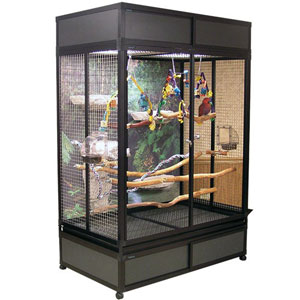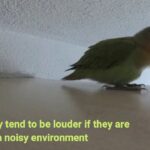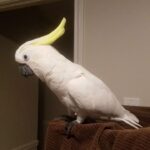A lovebird cage should be at least 24 inches wide, 24 inches deep, and 24 inches tall. Optimal cage size allows for flight and movement, reducing stress and promoting health.
Understanding the spatial needs of lovebirds is crucial for their wellbeing. These vibrant, sociable birds thrive when they have enough room to spread their wings and engage in natural behaviors. Lovebirds are active and playful creatures, necessitating a habitat that not only accommodates their physical size but also provides space for toys, perches, and exercise.
A properly sized cage ensures they have the opportunity to move freely, which is vital for their mental and physical health. Selecting the right enclosure can make a significant difference in your lovebird’s quality of life, influencing their happiness and longevity. Always remember to choose a cage where your feathered friend can live comfortably, mimic their natural activities, and feel secure within their environment.
Ideal Habitat For Lovebirds
Creating the ideal habitat for lovebirds is critical to their well-being. These vibrant parrots thrive when their environment closely resembles their natural habitat. It brings them joy and keeps them healthy. Here is a deep dive into what makes a lovebird’s perfect home, from space requirements to mimicking their natural environment.
Natural Environment Preferences
Lovebirds come from warm, wooded African regions. They love spaces that remind them of home. In captivity, providing a similar setting is essential. Lovebirds enjoy:
- Sunlight or full-spectrum lighting
- Branches to climb and chew on
- Sheltered areas for privacy
- Access to fresh air without direct drafts
Space Requirements For Health And Happiness
A cage for a lovebird must be spacious. These birds are active and require room to move. Below are the minimum requirements:
| Number of Lovebirds | Minimum Cage Size (Length x Width x Height) | Additional Notes |
|---|---|---|
| 1 Lovebird | 24 x 18 x 18 inches | Extra space for toys |
| 2 Lovebirds | 34 x 18 x 24 inches | Ensure multiple feeding stations |
These dimensions allow for ample flying, playing, and stretching. For optimal health, the bigger the cage, the better. Ensure there’s space for perches, toys, and feeding bowls without overcrowding.
Remember, daily out-of-cage time is crucial too. Lovebirds need interaction and exercise beyond their cages. This boosts their happiness and mental health.
Size Matters In Lovebird Caging
Lovebirds need space to spread their wings, play, and explore. A cramped cage can lead to stress, which may cause health issues. Selecting the right cage size is critical for their happiness and well-being. Let’s dive into the essential dimensions that will ensure a comfy home for these feisty feathered friends.
Minimum Size Recommendations
The smallest cage for a single lovebird measures 18 inches long by 18 inches wide by 18 inches high. For a pair, a 24″x24″x24″ cage is the least you should consider. These dimensions offer minimum space for sleep, eat, and play.
- One Lovebird: 18x18x18 inches
- Pair of Lovebirds: 24x24x24 inches
Optimal Cage Dimensions
While the minimum size is essential, bigger is always better for lovebirds.
| Optimal Cage Size for Lovebirds | ||
|---|---|---|
| Width: | Depth: | Height: |
| 36 inches | 24 inches | 24 inches |
Aim for a cage that’s at least 36 inches wide. This gives your lovebirds enough room to fly, climb, and play. A good cage also has safe bar spacing of about 1/2 inch to avoid escapes or injuries.
Remember, a spacious cage means a happier and healthier lovebird.
Factors Influencing Cage Size
Choosing the right cage for lovebirds is key to their happiness and health. Different factors play a role in deciding the perfect size. It’s not just about space; it’s about caring for your feathered friends properly. Let’s explore what can affect cage size requirements.
Number Of Lovebirds
More birds need more space. It’s simple. A single lovebird is happy in a smaller space. But multiple birds mean a larger cage is necessary. A good rule of thumb is to increase the cage size proportionally with the number of lovebirds:
| Lovebirds | Minimum Cage Size |
|---|---|
| 1 | 24 x 24 x 24 inches |
| 2 | 34 x 24 x 24 inches |
| 3+ | 40+ x 30+ x 30+ inches |
Remember, these sizes are minimums. Bigger is usually better for bird happiness.
Activity Level And Exercise Needs
Lovebirds are active and playful. They love to climb, swing, and explore. A small cage limits these activities, which can lead to stress or health issues. Here are features to consider:
- Space for flying and flapping
- Areas to climb and perch
- A variety of toys
Ensuring enough room for these playful antics is crucial. An ideal cage includes space for all these activities. Look for cages that are at least twice the wingspan of your bird in width and depth.

Credit: www.youtube.com
Cage Design And Features
Choosing the right cage for a lovebird is like picking a happy, healthy home for a beloved family member. Lovebird cage design and features play a crucial role in the well-being of these playful companions. Let’s explore the essentials such as bar spacing, orientation, accessibility, and safety concerns that ensure a lovebird’s home is both comfortable and secure.
Bar Spacing And Orientation
Proper bar spacing & orientation is vital. Bars too far apart can lead to escapes or injuries. Ideal spacing is:
| Age | Spacing |
|---|---|
| Adult | 1/2 to 5/8 inches |
| Babies | 1/2 inches or less |
Vertical bars offer great climbing fun, but both vertical and horizontal bars give more exercise options.
Accessibility And Safety Concerns
For accessibility, a cage must have doors that are:
- Easy to open for humans.
- Lockable to prevent escapes.
Entrances should be smooth without sharp edges to protect your lovebird from harm. Cages must be made of safe, non-toxic materials because lovebirds love to chew. Also, look for a sturdy design that won’t tip over easily.
Check for these safety features:
- Secure locks that birds cannot open.
- Solid construction to prevent accidents.
- No small parts that birds might swallow.
With the right design features, your lovebird will thrive in a safe, enjoyable space.
Inside The Cage: Furnishing A Lovebird Home
Creating a cozy home within a cage for lovebirds starts with understanding the essentials of a safe and stimulating environment. Lovebirds are active and playful, so their home should cater to these needs with appropriate furnishings. Proper cage setup promotes health, happiness, and a stronger bond with pet owners.
Essential Items and AccessoriesEssential Items And Accessories
To ensure lovebirds thrive, owners must include several key items:
- Perches of different sizes and materials for foot health.
- A secure nesting box for a sense of security.
- Durable feeders and waterers for easy access to food and water.
- Cuttlebone or mineral block for beak maintenance and calcium.
| Item | Description |
|---|---|
| Perches | Various diameters, materials |
| Nesting Box | Enclosed space for comfort |
| Feeders | Accessible food containers |
| Waterers | Clean water dispensers |
| Cuttlebone | Calcium source, beak care |
Creating Stimulating Environments
A lovebird’s cage is more than a living space. It’s a world of play, discovery, and exercise. To spark joy and mental stimulation, include:
- Toys that encourage foraging and problem-solving.
- Ladders and swings for physical activity.
- Mirrors for social birds to interact with their reflection.
- Hiding spots like foliage or bird-safe tents for privacy.
Rotate toys and accessories regularly to keep your lovebird’s interest peaked and prevent boredom. A diverse environment leads to a happy and healthy lovebird.

Credit: www.customcages.com
The Impact Of Cage Size On Lovebird Behavior
The Impact of Cage Size on Lovebird Behavior cannot be overstated. A lovebird’s home affects its health, happiness, and well-being. Understanding how cage size influences their behavior is crucial for any lovebird owner. Let’s delve into the specifics.
Social Interaction And Space
Lovebirds are inherently social creatures. They thrive on interaction, both with their human families and feathered partners. An optimal cage size allows lovebirds ample space to socialize and play. This physical space is not just a luxury; it’s a necessity for their social behavior.
- A larger cage encourages lovebirds to flap their wings, climb, and explore.
- Sufficient space helps prevent territorial disputes that can occur in cramped environments.
- A cage with room for toys and perches promotes mental stimulation and physical activity.
Stress And Confinement Issues
Confinement in a small cage can lead to stress and behavioral problems in lovebirds. The link between their living space and mental health is clear.
- Stress behaviors include feather plucking, aggression, and excessive chirping.
- A proper cage helps mitigate stress by providing freedom of movement and opportunities for enrichment.
- Ample space helps prevent the development of neurotic behaviors associated with small, restrictive cages.
Upgrading Your Lovebird’s Living Space
Your lovebird deserves a comfortable and spacious home to thrive and be happy. Like us, birds also need room to stretch, play, and explore. Upgrading your lovebird’s living space is not just about size, but about improving their quality of life. A properly sized cage can make all the difference. Let’s dive into the specifics of when and how to upgrade, along with the best way to transition your feathered friend to their new, larger habitat.
When And How To Upgrade
Signs it’s time to upgrade your lovebird’s cage include:
- Feathers get ruffled due to lack of space.
- The bird seems overly agitated or stressed.
- There’s not enough room for toys or exercise.
Once you decide an upgrade is necessary:
- Measure the space where the new cage will go.
- Choose a cage that is at least double the size of the old one.
- Ensure it has safe bar spacing and is made of non-toxic materials.
Transitioning To A Larger Habitat
Transition can be stressful for lovebirds. To make it smooth:
- Place the new cage next to the old one for a few days.
- Transfer familiar toys and perches to the new cage.
- Gradually increase time spent in the new cage each day.
Keep the routine consistent to help your lovebird adjust. Soon, they will enjoy their new space, engaging in play and exercise that’s crucial for their wellbeing. Remember, a spacious and enriched environment leads to a happier and healthier lovebird.
Maintenance And Hygiene Of A Lovebird Cage
When it comes to keeping your lovebird healthy, cage maintenance and hygiene cannot be overlooked. Just like your home, a clean environment means a happy and healthy lovebird. Let’s dive into the realm of keeping your lovebird’s cage not just cozy, but spotless too!
Cleaning Schedules And Techniques
Regular cleaning is key for your lovebird’s health. Here’s a simple schedule and some techniques to follow:
- Daily: Remove any uneaten food and droppings.
- Weekly: Change the cage liner and wash the food and water dishes.
- Monthly: Deep clean the entire cage with bird-safe products.
For the technique, always:
- Wear gloves to protect your hands.
- Use a scrub brush for the bars and tough spots.
- Rinse the cage thoroughly with hot water to remove soap residue.
Preventing Disease Through Proper Upkeep
Maintaining your lovebird’s cage properly prevents disease. Implement these steps:
| Action | Benefit |
|---|---|
| Disinfect regularly | Kills germs and parasites |
| Keep perches clean | Prevents foot sores |
| Avoid dampness | Reduces mold growth |
Remember to replace any damaged toys and accessories. This avoids injuries and ingestion of harmful materials.

Credit: www.wikihow.pet
Conclusion
Selecting the right cage size is paramount for your lovebird’s happiness and health. Aim for a habitat where they can fly, play, and explore safely. Remember, generous dimensions, appropriate bar spacing, and sturdy materials make the ideal home. Give your feathered friend the gift of space for a fulfilling life.
Ryan Everhart is a passionate bird enthusiast and blogger, primarily writing on his website, Avian Whispers. His journey into the world of bird blogging began with a deep interest in parrots, a species that captivated his attention for their intelligence and social behavior. Over time, his content expanded to cover a broader range of bird species, offering insights into bird behavior, care, habitats, and conservation.
Ryan is dedicated to educating his audience, which includes both new bird owners and seasoned enthusiasts. His writing is filled with personal experiences, expert knowledge, and practical advice on bird care. Through Avian Whispers, he aims to foster a deeper appreciation for birds, emphasizing their role in nature and the joys of having them as pets.
Starting with articles focused on parrots, Ryan’s work now encompasses a diverse range of topics such as feeding, training, habitat enrichment, and bird health. His love for birds extends beyond parrots, diving into various avian species. His informative and heartfelt writing reflects his commitment to the well-being of birds and the desire to help others connect with these creatures.
As a growing voice in the bird blogging community, Ryan strives to provide a platform where bird lovers can learn, share experiences, and connect over a shared passion for avian life. His blogs are not only educational but also serve as a reminder of the importance of protecting and nurturing the bond between humans and birds.




